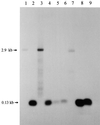RNase III processing of intervening sequences found in helix 9 of 23S rRNA in the alpha subclass of Proteobacteria
- PMID: 10940010
- PMCID: PMC111346
- DOI: 10.1128/JB.182.17.4719-4729.2000
RNase III processing of intervening sequences found in helix 9 of 23S rRNA in the alpha subclass of Proteobacteria
Abstract
We provide experimental evidence for RNase III-dependent processing in helix 9 of the 23S rRNA as a general feature of many species in the alpha subclass of Proteobacteria (alpha-Proteobacteria). We investigated 12 Rhodobacter, Rhizobium, Sinorhizobium, Rhodopseudomonas, and Bartonella strains. The processed region is characterized by the presence of intervening sequences (IVSs). The 23S rDNA sequences between positions 109 and 205 (Escherichia coli numbering) were determined, and potential secondary structures are proposed. Comparison of the IVSs indicates very different evolutionary rates in some phylogenetic branches, lateral genetic transfer, and evolution by insertion and/or deletion. We show that the IVS processing in Rhodobacter capsulatus in vivo is RNase III-dependent and that RNase III cleaves additional sites in vitro. While all IVS-containing transcripts tested are processed in vitro by RNase III from R. capsulatus, E. coli RNase III recognizes only some of them as substrates and in these substrates frequently cleaves at different scissile bonds. These results demonstrate the different substrate specificities of the two enzymes. Although RNase III plays an important role in the rRNA, mRNA, and bacteriophage RNA maturation, its substrate specificity is still not well understood. Comparison of the IVSs of helix 9 does not hint at sequence motives involved in recognition but reveals that the "antideterminant" model, which represents the most recent attempt to explain the E. coli RNase III specificity in vitro, cannot be applied to substrates derived from alpha-Proteobacteria.
Figures







Similar articles
-
RNase E is involved in 5'-end 23S rRNA processing in alpha-Proteobacteria.Biochem Biophys Res Commun. 2002 Dec 20;299(5):780-6. doi: 10.1016/s0006-291x(02)02738-9. Biochem Biophys Res Commun. 2002. PMID: 12470646
-
Characterization of a separate small domain derived from the 5' end of 23S rRNA of an alpha-proteobacterium.Nucleic Acids Res. 1999 Nov 1;27(21):4241-50. doi: 10.1093/nar/27.21.4241. Nucleic Acids Res. 1999. PMID: 10518617 Free PMC article.
-
Divergent mechanisms of 5' 23S rRNA IVS processing in the alpha-proteobacteria.Nucleic Acids Res. 2000 Dec 1;28(23):4623-33. doi: 10.1093/nar/28.23.4623. Nucleic Acids Res. 2000. PMID: 11095671 Free PMC article.
-
RNase P from bacteria. Substrate recognition and function of the protein subunit.Mol Biol Rep. 1995-1996;22(2-3):99-109. doi: 10.1007/BF00988713. Mol Biol Rep. 1995. PMID: 8901495 Review.
-
The multifaceted roles of the RNA processing enzyme ribonuclease III.Indian J Biochem Biophys. 1996 Aug;33(4):253-60. Indian J Biochem Biophys. 1996. PMID: 8936814 Review.
Cited by
-
High-quality permanent draft genome sequence of Bradyrhizobium sp. Ai1a-2; a microsymbiont of Andira inermis discovered in Costa Rica.Stand Genomic Sci. 2015 Jun 14;10:33. doi: 10.1186/s40793-015-0007-z. eCollection 2015. Stand Genomic Sci. 2015. PMID: 26380037 Free PMC article.
-
The Intervening Sequence of Coxiella burnetii: Characterization and Evolution.Front Cell Infect Microbiol. 2016 Aug 19;6:83. doi: 10.3389/fcimb.2016.00083. eCollection 2016. Front Cell Infect Microbiol. 2016. PMID: 27595093 Free PMC article.
-
The pseudouridine synthase RluD is required for normal ribosome assembly and function in Escherichia coli.RNA. 2005 Jul;11(7):1141-52. doi: 10.1261/rna.2550105. Epub 2005 May 31. RNA. 2005. PMID: 15928344 Free PMC article.
-
RNase E cleavage shapes the transcriptome of Rhodobacter sphaeroides and strongly impacts phototrophic growth.Life Sci Alliance. 2018 Aug 1;1(4):e201800080. doi: 10.26508/lsa.201800080. eCollection 2018 Aug. Life Sci Alliance. 2018. PMID: 30456366 Free PMC article.
-
Atypical processing in domain III of 23S rRNA of Rhizobium leguminosarum ATCC 10004(T) at a position homologous to an rRNA fragmentation site in protozoa.J Bacteriol. 2002 Jun;184(12):3176-85. doi: 10.1128/JB.184.12.3176-3185.2002. J Bacteriol. 2002. PMID: 12029033 Free PMC article.
References
-
- Amarger N, Macheret V, Laguerre G. Rhizobium gallicum sp. nov. and Rhizobium giardinii sp. nov., from Phaseolus vulgaris nodules. Int J Syst Bacteriol. 1997;47:996–1006. - PubMed
-
- Ausubel F M, Brent R, Kingston R E, Moore D D, Seidman J G, Smith J A, Struhl K. Current protocols in molecular biology. I. New York, N.Y: Greene Publishing Associates and Wiley-Interscience; 1989.
-
- Beringer J E. R-factor transfer in Rhizobium leguminosarum. J Gen Microbiol. 1974;84:188–198. - PubMed
-
- Burgin A B, Parodos K, Lane D J, Pace N R. The excision of intervening sequences from Salmonella 23S ribosomal RNA. Cell. 1990;60:405–414. - PubMed
Publication types
MeSH terms
Substances
Associated data
- Actions
- Actions
- Actions
- Actions
- Actions
- Actions
- Actions
- Actions
- Actions
- Actions
- Actions
- Actions
- Actions
LinkOut - more resources
Full Text Sources
Molecular Biology Databases

